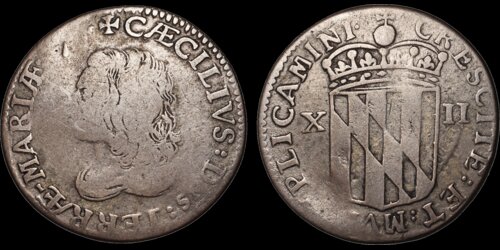Search All Current Lots for Sale:
E-Auction 51 Lot 272

COLONIAL AMERICA. Lot 272. Lord Baltimore shilling. 4.94 gm. 25 mm. Large Bust. Produced in London (possibly Tower mint). (1659). Bust of Cecil Calvert, the second Lord Baltimore left; CAECILIVS Dns TERRÆ-MARIÆ ("Cecil, Lord of Mary's Land") / Arms of Baltimore; X - II flanking. Hodder 1-A. Whitman 1080. Breen 64. Near Fine; though the portrait is worn, most of the other detail and lettering is clear and the metal is even and good quality; the tone of the entire piece is an attractive and uniform gray; published images of this type show that metal flaws, damage, and rough surfaces are common for the issue. All examples of this coinage are scarce to rare, and are typically not well struck.
In 1632 Cecil Calvert, the second Baron Baltimore, inherited vast holdings of land in what would later become Maryland. In 1659, believing that his Royal Charter gave him the right to strike coins, he arranged for a small issue of coins to be produced in his name by the Royal Mint in London to support the local agrarian economy which was beginning to be hampered by the use of locally produced goods (especially tobacco) as barter in nearly all transactions. There was some difficulty when it came time to export the coins to the Americas, and Calvert was arrested, the warrant issued by the Clerk of the Irons in the Mint stating that he "and diverse others with him, and for him, have made and transported great Sums of mony and doe still goe on to make more." The transport, and the fact that the coinage was minted at a lower (stirling) fineness from the official standards, seem to have led to the arrest. There are no records of how any proceedings may have gone, but they were seemingly short-lived and there are no records of further consequences, with Calvert living until 1675. Once hoped to serve as a currency across the colonies, the coinage had largely disappeared by the 1700s, with many remaining examples holed for suspension. All examples are scarce to rare today.

